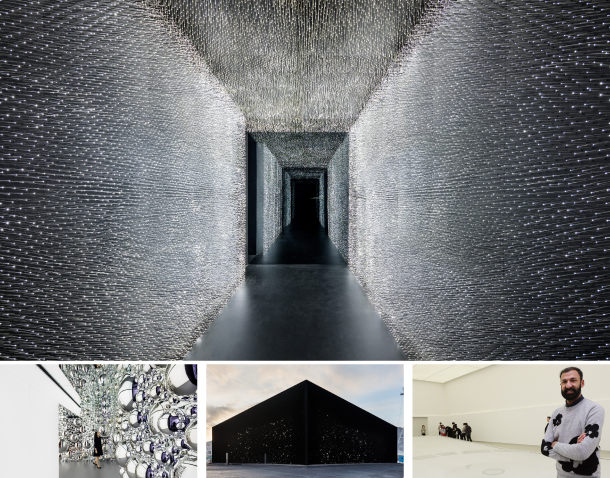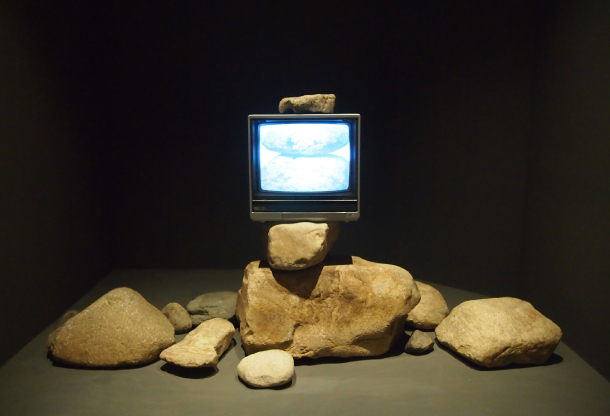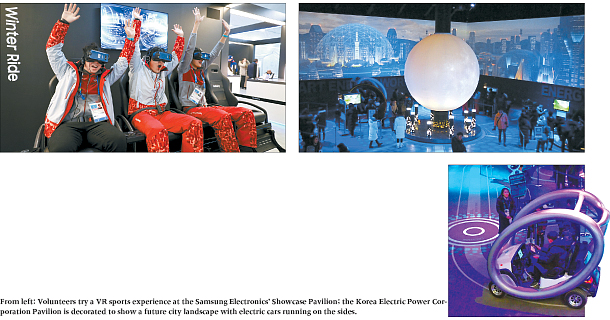Olympic pavilions offer a look into the future : In PyeongChang, brands put their best foot forward to show off Korean excellence to the world

The Hyundai Motor Pavilion is a visual representation of the future of hydrogen fuel through an art and architecture exhibition instead of just putting vehicles on display. The exhibition shows hydrogen in different forms, such as electricity, top, or being separated from water particles, above left. On the facade is “Universe,” above middle, and “Water,” above right, with architect Asif Khan standing in front of his work. [HYUNDAI MOTOR, YONHAP]
The Olympic Plaza in Pyeongchang sits next to the Olympic Stadium where the opening and closing ceremonies are being held. It houses five showcase pavilions organized by five different brands, as well as a culture-technology pavilion that has been set up by the PyeongChang Organizing Committee.
Art lovers must make sure to visit the black Hyundai Motor Pavilion, and the Culture-ICT Pavilion, which is covered with images projected on its outer walls and stands next to the Traditional Experience Booth. For those curious about the future of technology, make sure to take the time to visit the pavilions set up by Samsung, Korea Electric Power Corporation and the Korea Creative Content Agency to try out high quality VR and AR (augmented reality) gadgets.
Each pavilion will be open until the final day of the Olympics on Feb. 25, then again during the Paralympics from March 9 to 18. After the Winter Games, the Olympic Plaza will be turned into an Olympic Park, but none of the pavilions will remain, so be sure to make a visit before the games end.
Hyundai Motor Pavilion
Though every exhibit offers something special for Olympic attendees, what awaits them at the Hyundai Motor Pavilion is nothing one would expect to see at a carmaker’s showcase. Rather than displaying shiny cars and fancy gadgets, Hyundai Motor decided to do something completely different: create an art exhibit both inside and outside of its pavilion walls.
The “Hyundai Pavilion” is a visual representation of the future, in which transportation will run on hydrogen, not oil. The entire exhibition is centered around the idea of hydrogen, as the company will start selling Nexo, a hydrogen-powered car, in March. The pavilion is divided into three different sections - “Universe” and “Water,” which were both created by renowned architect Asif Khan, and “Hydrogen,” which was designed by the company’s art team.
From afar, the building looks more like a large, square hole in the sky filled with stars than a typical black building. Each of the outer walls is a parabolic curve that absorbs as much light as possible, amplifying the material that covers the walls - Vantablack VBx 2, the blackest nano material on Earth, which absorbs 99.7 percent of light it is exposed to.
“I wanted [to create] this feeling like you took a knife and cut out a part of reality, and you see through to the universe and beyond,” said Khan to Korean press on Feb. 12 in Pyeongchang. “What is hydrogen? It’s a gas, but you can’t see it and you can’t smell it. But of course, we remembered that the stars in the sky are made out of hydrogen. That’s something you see on a daily basis. And we don’t just see it, we find it inspiring. It’s part of every story and probably every religion as well.”
Stepping inside the building offers a stark contrast to the incredible darkness on the outside. Immediately upon entering the first section, visitors stand in a white room, completely shut off from the high-energy Olympic atmosphere outside.
The exhibit encourages visitor participation. Those inside can take a cup of water and pour it into a structure which disperses the liquid into droplets. These droplets flow down canals that are meticulously controlled by 25,000 sensors underneath the structure. Then people can rest their legs and sit at the other end of the installation, watching the droplets form a small lake.
“It’s a completely white space and it’s a contrast [to the outside], to slow you down and calm you down,” said Khan. “We wanted the water, which is a byproduct of hydrogen and part of the hydrogen fuel cell cycle, to come to life.”
The next section “Hydrogen” is a walk through four different uses of element: solar power, water electrolysis, fuel cells and clean water. Each passage is a visual representation of the different forms of hydrogen, which are easy for the audience to grasp even without a deep understanding of science. For instance, the solar power zone shines with an orange light like the sun, while the walls of the water electrolysis zone are filled with circular ovals that represent water and hydrogen particles.
“The word pavilion comes from the French word for butterfly. It comes into existence and then flies off and disappears. The magic of a pavilion is that they exist for a moment, and you have to be here to see it,” said Khan.

A piece by media artist Park Hyun-ki is on display at the Culture-ICT Pavilion, which has traveled from Seoul for the Olympics. [YOON SO-YEON]
Just a few steps away from the Hyundai Pavilion is the Culture-ICT Pavilion organized by the PyeongChang Organizing Committee. As telling as the name is, the two-floor building offers a cultural experience on its first floor, and an information and communications technology showcase on the second.
The first floor is a cultural multiplex of different art works and performances, including media art, sculptures and paintings. Many of the works on display have travelled to Pyeongchang from the archives of the Museum of Modern and Contemporary Art in Seoul, including media art works by renowned artist Nam June Paik and paintings by Kim Whanki and Lee Ufan.
The exhibit offers a tour twice a day at 1 p.m. and 4 p.m., and performances are held everyday in the media art zone, so be sure to check out the schedule for the best experience.
The second floor is a digital heaven that shows off Korea’s five most promising advancements in technology: 5G, the internet of things (IoT), ultra high definition (UHD) screens, artificial intelligence and VR. The space offers VR experiences of some of the winter Olympic sports such as snowboard and bobsleigh, an artificial intelligence display that takes visitors on a tour around the Gangwon region and the latest language translation service for foreign visitors.
The 2018 PyeongChang Olympic seeks to be more than just a sports gathering, and the Culture-ICT Pavilion is the best place to witness Korea’s major cultural and technological advancements.

[YONHAP, YOON SO-YEON]
A few minutes away from the two art facilities are sculptures by Coca Cola and pavilions from Samsung, Korea Electric Power Corporation and the Korea Creative Content Agency.
After taking a photo at the Coca Cola installations, which look like giant red-and-white boxes of the sweet drink, the ultimate high-tech tour starts inside Samsung Electronics’ Showcase Pavilion, where visitors queue up to wait for their turn on one of the exciting VR rides. The pavilion lets a limited number of people inside at once, so that everyone has the opportunity to try each of the 11 winter sport simulations on offer.
The Korea Electric Power Corporation Pavilion is also a popular spot. Upon entering, visitors will find themselves standing in awe of what is inside the main hall, which has been turned into a mini city of the future, with a massive glowing moon in the center and electric cars running through roads on the sides. Screens throughout the exhibit show the landscape of a future city where electricity is the main power source, instead of fossil fuels.
“We opened up on Feb. 9, and get about 3,000 to 4,000 visitors everyday because the word got out that it’s so fun,” said a staff member at the electricity corporation’s pavilion.
Last, but not least is the Live Pavilion organized by the Korea Creative Content Agency. The hall is full of cutting edge technology much like the other pavilions, but it will especially appeal to K-pop fans.
Every hour from 12:30 p.m. to 10:30 p.m., there’s the “Live Holo Concert” where visitors can meet their favorite K-pop stars via hologram projected on the stage. The program changes everyday, and reservations can be made on site for free.
After a thorough tour around the Olympic Plaza, stop by the Mega Store before you leave. The massive souvenir shop is the ultimate place to everything Olympic-related and is fun to look around even if you don’t make a purchase, with all sorts of Olympic goods decorated with the Games’ two mascots Soohorang and Bandabi, as well as sportswear and shoes printed with Olympic logos, so you can leave the Olympic Plaza looking like one of the athletes.
BY YOON SO-YEON [yoon.soyeon@joongang.co.kr]










with the Korea JoongAng Daily
To write comments, please log in to one of the accounts.
Standards Board Policy (0/250자)